
* Late in World War II, the Republic Aviation company came up with a design for a single-engine jet fighter, which would emerge as the "F-84 Thunderjet". It served with distinction in the Korean War. After the conflict, it was supplanted by a swept-wing derivative, the "F-84F Thunderstreak", which was also built as a reconnaissance aircraft, the "RF-84F Thunderflash". This document provides a history and description of the F-84 family. A list of illustration credits is included at the end.
* In 1944, Republic Aviation began design work on the company's first jet fighter, a successor to the combat-proven Republic P-47 Thunderbolt. The "AP-23", as the company designated it, was designed by a development team under Republic's chief designer, Alexander Kartveli. The aircraft was to be powered by one of the very first American axial-flow turbojet engines, the General Electric (GE) TG-180. On 11 November 1945, the US Army Air Forces (USAAF) awarded Republic a contract for three prototypes, plus a static-test airframe, with the designation of "XP-84". The first XP-84 "Thunderjet", as the type was known, performed its initial flight on 28 February 1946 from Muroc Air Base -- now Edwards Air Force Base -- in California, the pilot being Major William A. Lein.
Although Kartveli had considered modifying the P-47 to turbojet propulsion, that idea proved unworkable, and so the XP-84 was a new design that owed little or nothing to the Thunderbolt. The Thunderjet's configuration was basically that of a "flying stovepipe", with an intake in the nose, and an airframe configuration that did reflect Republic's piston-fighter past: straight low-mounted wings, a conventional tail arrangement, a bubble canopy that slid back to open, and tricycle landing gear.
The XP-84 was powered by a J35-GE-7 turbojet, a production version of the TG-180, with 16.7 kN (1,700 kgp / 3,750 lbf) thrust. The wing was thick to permit fuel storage, there being no space for fuel tanks in the fuselage; the tailplane was at the base of the tailfin. Flight controls were conventional -- flaps, ailerons, elevators, rudder -- and manually actuated. All the landing gear assemblies had single wheels, the nose gear retracting backwards, the main gear pivoting in from the wings towards the fuselage. The main gear legs were long, being hydraulically compressed when retracting. The entire aft fuselage could be unbolted and pulled off for engine maintenance. There was a hydraulically-actuated dive brake on the belly between the wings, and a bumper under the tail to protect against tailstrikes.
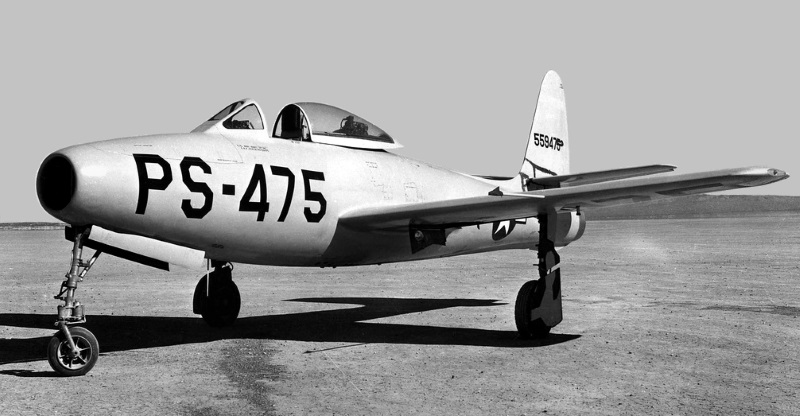
The second prototype was flying in August 1946. On 7 September 1946, it set a US national speed record of 983 KPH (611 MPH) -- just short of the contemporary international speed record set by the British Gloster Meteor F.4 of 992 KPH (616 MPH). That record wouldn't stand for long, with aircraft speed records falling in rapid succession for over a decade.
Deficiencies uncovered in initial prototype flight tests led to considerable revision of the third prototype, which emerged as the "XP-84A". The changes led to a greater take-off weight, and so the YP-84A was fitted with an Allison-made J35-A-15 turbojet with 17.8 kN (1,815 kgp / 4,000 lbf) thrust. GE had been having trouble delivering an adequate supply of J35s, so Allison was brought in as an alternate source. Engine availability would prove a troublesome issue for the Thunderjet development program.
Even before the flight of the first prototype, on 4 January 1945, the USAAF had awarded a contract to Republic for 25 service evaluation machines and 75 production machines -- though the numbers were later changed to 15 and 85 respectively. The 15 "YP-84A" service evaluation machines featured a more were similar to the XP-84A, the major changes being armament of six 12.7-millimeter (0.50-caliber) M2 Browning machine guns -- four in the nose above the air intake, one in each wing root -- and provision for wingtip external tanks with a capacity of 872 liters (230 US gallons) each. One of them was later experimentally fitted with a solid nose and flush intakes, low on the nose in front of the canopy.
* The initial production version was the "P-84B", with an Allison J35-A-15C engine, providing the same thrust as the J35-A-15; faster-firing M3 Browning machine guns; and an ejection seat, which would not be cleared for use and not armed. Most or all of the YP-84As were brought up to P-84B standard. From the 86th example on, the P-84B featured retractable launch rails for eight 12.7-centimeter (5-inch) "High Velocity Air Rockets (HVARs)". The Thunderjet also had a retractable bomb rack near the wing root on each wing. The rack could carry a 225-kilogram (500-pound) bomb or comparable store. Although the prototypes were painted early on, the paints available at the time tended to peel off readily at high speeds, and so Thunderjets would typically fly in natural-metal finish.
Initial deliveries of the P-84B, to the 14th Fighter Group, were in the summer of 1947, roughly at the time when the USAAF became the US Air Force (USAF). A total of 226 P-84B machines was delivered from August 1947 to February 1948, with the type redesignated the "F-84B" when the Air Force modified their aircraft designation scheme in 1948. The F-84B left a lot to be desired in terms of serviceability and reliability, being often in the hangar; surprisingly for a Republic aircraft, it wasn't very sturdy. It had been rushed into service with inadequate qualification, and would never be judged acceptable for combat service. It was called a "Mechanic's Nightmare", problems being compounded by the difficulty of obtaining replacement parts.
An update program was begun in 1949 to bring the F-84Bs up to better spec. Two were also modified to evaluate a scheme where they were towed behind a B-29 Superfortress to provide an escort for the bomber, with these machines redesignated "EF-84B". The idea proved impractical.
The F-84B was followed by 191 "F-84C" machines from May 1948, which were similar to the F-84B but featured a revised electrical system and a more reliable J35-A-13C engine, with the same thrust as the J35-A-15. The F-84C, unfortunately, wasn't much more ready for service than the F-84B; the ejection seat would still not be qualified for use. The F-84C wouldn't see combat either, and both variants were quickly passed on to training and Air National Guard (ANG) units, with the last of them out of service by 1954. 80 F-84Bs were obtained by the US Navy as "F-84KX" unpiloted target drones, which was probably an appropriate use for them.

* The next version, the "F-84D", was a fast-track attempt to quickly correct the worst deficiencies of the Thunderjet until a comprehensive redesign could be put into production; Republic was under a lot of pressure to get the F-84 to work, with the Air Force considering cancellation of the program. The USAF put the F-84D through trials and determined it was more satisfactory than its predecessors -- if not that much more. One problem was that many of the fixes were introduced in the course of production, with the result that the F-84 still remained a "Mechanic's Nightmare". In any case, the F-84D featured:
Other changes included a winterized fuel system; a fin outboard on each wingtip tank that prevented them from flexing the wings in flight; the pitot tube relocated from the top of the tailfin to the engine intake; fixed instead of retractable bomb racks; and a quick-release canopy. Incidentally, the ejection seat was finally cleared for use. 154 F-84D machines were delivered from November 1948 to April 1949. The last of them had been withdrawn from service by 1954.
* The Air Force tolerated the F-84D on the basis that the comprehensive redesign effort would finally yield a good aircraft. The result was the "F-84E", the definitive Thunderjet, which was optimized as a fighter-bomber and featured:
The F-84E could carry an external load of 2,040 kilograms (4,500 pounds). It retained the J35-A-17D engine of the F-84D. Initial flight of the first F-84E was on 18 May 1949. A total of 843 F-84E machines was built up to July 1951, with the type serving in the Korean conflict and about a hundred of them passed on to NATO forces, mostly the French Armee de l'Air, under the US Military Defense Assistance Program (MDAP).
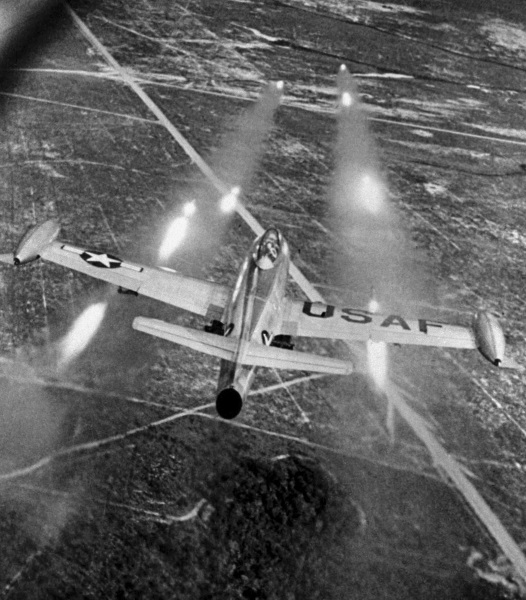
The F-84E was used for trials of in-flight refueling using probe-&-drogue refueling, with two "EF-84E" test machines built to evaluate the concept. One EF-84E was the first jet aircraft to make a nonstop trans-Atlantic crossing, on 22 September 1950. F-84Es in operational service were in some cases fitted with tip tanks featuring a refueling probe.
* The Thunderjet saw significant combat with US forces. Following the invasion of South Korea by North Korea on 25 June 1950, US and South Korean forces were pushed back into a perimeter around Pusan, in the southeast corner of Korea. On 10 September, a US amphibious force landed at Inchon, the port of Seoul, effectively cutting off the supply lines to North Korean forces to the south, and leading to their rapid pull-out north.
The decision was made to pursue the fleeing enemy north, with US and South Korean forces all but overrunning North Korea -- only to be sent fleeing back south in turn, when the Chinese intervened in October. Soviet dictator Josef Stalin supported the drive, most visibly by deploying the swept-wing Mikoyan MiG-15 fighter, flown by Soviet pilots, to provide air cover. The US quickly introduced more advanced aircraft into the battle.
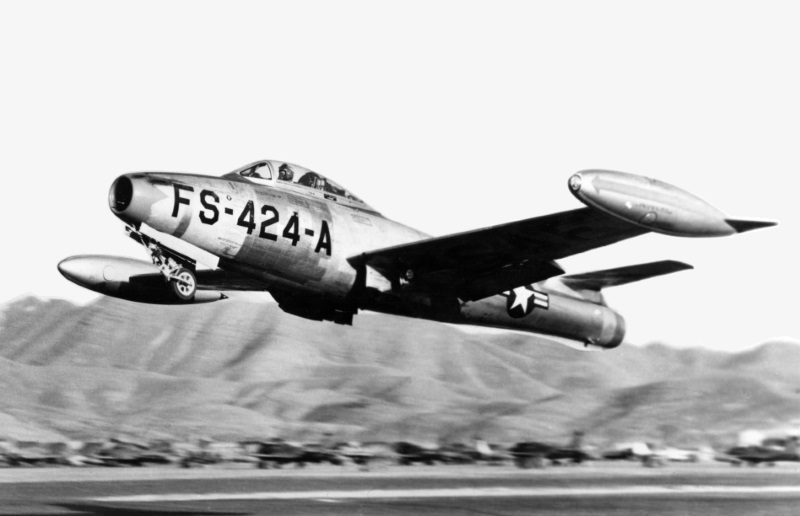
F-84D/Es were sent to the theater, getting into the fight by early December, operating out of the airbase at Taegu initially providing escort for Boeing B-29 Superfortress bombers. The Thunderjet, a first-generation jet fighter, proved no match for the MiG-15, being slower and less agile, with 18 Thunderjets lost for the destruction of 9 MiG-15s. The second-generation North American F-86 Sabre took over the air combat role, with the F-84 finding its niche as a strike aircraft, replacing the Lockheed F-80 Shooting Star in that role. F-84s performed attacks with guns, rockets, bombs, and napalm tanks; the type was seen as a stable gun platform, with pilots becoming skilled in accurately dropping munitions, and could soak up hits that would have brought down other types of aircraft.
The F-84E took up most of the load, the F-84D not being seen as particularly acceptable for combat service -- it was slower, had shorter range, and the cramped cockpit was intolerable for larger pilots. Many F-84Ds sent into the theater were simply parked and effectively forgotten.
By early 1951, the war had settled into a stalemate, the two sides jockeying for position in negotiations in bitter fighting along the front lines. The US attempted, with limited success, to influence the outcome using air power, the F-84 keeping busy with ground strikes -- not just on tactical targets, but also on infrastructure targets such as dams and bridges, such strikes being performed with two 450-kilogram (1,000-pound) bombs, which the F-84E had enough engine power to carry.
From 1952 into 1953, Japan-based Thunderjets, fitted with probe-equipped tip tanks, performed the first air combat operations using inflight refueling -- though the HIGH TIDE missions, as they were codenamed, were limited in number, operations from Japan being only required by congestion at the main F-84 base in Taegu, and rendered unnecessary by building up Taegu.
Although the Thunderjet acquitted itself well in operational service it was, like the P-47 before it, regarded as an "Earth lover", disinclined to get into the air, particularly in warm weather and with a heavy load, being nicknamed the "Lead Sled", the "Hog", and "Super Hog". It was said that if a runway was built that went around the world, Republic would build an aircraft that needed all of it. It was, however, easy enough to fly once in the air, though it was hazardous to exceed maximum speed in a dive.
After the conflict, F-84Ds were gradually handed over to Air National Guard (ANG) units, to be finally withdrawn in 1957. The F-84E was phased out of first-line USAF service in the mid-1950s, finally being withdrawn from ANG / Air Force Reserve (AFR) service in 1959.
* The final version of the Thunderjet was the "F-84G" -- there was an "F-84F", but it was a more advanced aircraft than the Thunderjets and is discussed in the next section of this document; delays in the F-84F program led to production of the F-84G as a stop-gap, intended for the nuclear strike role. Initial deliveries were in 1951.
The F-84G featured a J35-A-29 engine with 24.9 kN (2,540 kgp / 5,600 lbf) thrust, the inflight refueling capability demonstrated on the EF-84E, and an autopilot to help fly the long missions enabled by inflight refueling. Originally, the F-84G used a boom refueling scheme, but this was replaced by a probe-and-drogue arrangement. The F-84G introduced a framed canopy replacing the bubble canopy of earlier variants, which had proven insufficiently robust; the framed canopy was generally refitted to earlier machines.
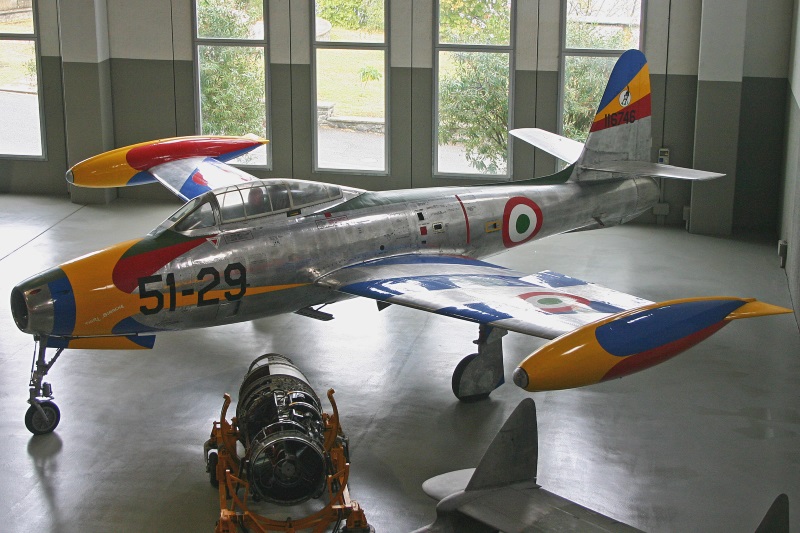
The F-84G could carry up to 1,815 kilograms (4,000 pounds) of conventional ordnance. The F-84G was the USAF's first operational nuclear strike fighter, adapted to carry the new 545-kilogram (1,200-pound) Mark 7 tactical nuclear weapon -- with yield programmable from 7 to 61 kilotons -- and using a "Low Altitude Bombing System (LABS)" to deliver the store. LABS permitted the F-84G to perform "toss bombing", with the aircraft releasing the bomb in a climb, the bomb arcing back down over the target while the fighter made its getaway.
___________________________________________________________________
REPUBLIC F-84G THUNDERJET:
___________________________________________________________________
wingspan:
11.09 meters (37 feet 5 inches)
wing area:
24.15 sq_meters (260 sq_feet)
length:
11.60 meters (38 feet 1 inch)
height:
3.91 meters (12 feet 10 inches)
empty weight:
5,035 kilograms (11,095 pounds)
MTO weight:
10,670 kilograms (23,525 pounds)
max speed at altitude:
925 KPH (575 MPH / 500 KT)
max speed, sea level:
1,000 KPH (620 MPH / 540 KT)
service ceiling:
12,350 meters (40,500 feet)
range, internal fuel:
1,075 kilometers (670 MI / 580 NMI)
max range with tanks:
3,220 kilometers (2,000 MI / 1,740 NMI)
___________________________________________________________________
Initial deliveries of the F-84G to the USAF Tactical Air Command (TAC) were in 1951, with a total of 3,025 F-84G machines delivered by end of production of the Thunderjet series in July 1953, making the F-84G the most heavily produced version of the F-84 series by far. 789 F-84Gs went to the USAF, which put them to good use in Korea, the variant going into combat in the theater in 1952. An armistice put an end to the fighting on 27 July 1953; by that time, the F-84 had flown over 86,000 sorties, dropping tens of thousands of tonnes of bombs and expending tens of thousands of rockets. At least 335 Thunderjets were lost -- over half to accidents, the bulk of the rest to ground fire.
The other 2,336 F-84Gs went to US allies under MDAP. Users included Belgium, Denmark, France, Iran, Italy, the Netherlands, Norway, Portugal, Taiwan, Thailand, Turkey, and even Yugoslavia. A number of European nations used the F-84E or F-84G in the reconnaissance role, with the wingtip tanks replaced by camera pods.
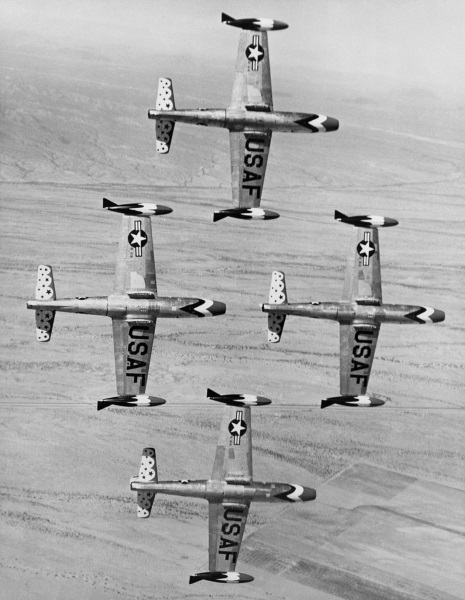
The F-84G was the mount for the Air Force Thunderbirds flight demonstration team from 1953 into 1955, and was also flown by the USAF / Europe flight demonstration team, the Skyblazers. A handful of F-84Gs were used to sample fallout from nuclear tests during 1955, these machines having their wingtip fuel tanks replaced by sampling pods, containing filters to pick up atomic debris. These aircraft had to be decontaminated after landing. The F-84G didn't have the altitude performance to be very acceptable for the job, being replaced in the sampling role by the Martin B-57 Canberra.
A total of 4,457 Thunderjets was built in all, including the three prototypes. The last operator of the Thunderjet was Portugal, which phased out its F-84Gs in 1976.
BACK_TO_TOP* Republic engineers felt they could take advantage of research obtained from the Germans on swept-wing aircraft to build a faster version of the Thunderjet. In late 1949, using company funds the "AP-23M" effort modified the 409th production F-84E with wings with a 40-degree sweepback plus a similarly swept tail assembly, and fitted it with a J35-A-25 engine providing 23.1 kN (2,360 kgp / 5,200 lbf) thrust; it also had a vee-shaped windshield to improve streamlining. The modified aircraft performed its first flight on 3 June 1950 and demonstrated some promise, being clocked on one test flight at a low-altitude speed of 1,115 KPH (693 MPH).
The Air Force was initially not very interested in Republic's work on the "YF-96A", as the type was initially designated -- but with the outbreak of the Korean War and subsequent encounters with the MiG-15, USAF interest increased sharply. A production contract was awarded in July 1950, with the contract stipulating fit of a more powerful Wright J65 turbojet, was a license-built copy of the British Armstrong Siddeley Sapphire engine. In September, the type was redesignated "F-84F", Air Force brass thinking it easier to sell Congress a variant of an existing machine than an entirely new aircraft. It did get a new name, however: "Thunderstreak".
The initial prototype, redesignated the "YF-84F", was re-engined with an imported Sapphire engine, flying for the first time in its new configuration on 14 February 1951. The fuselage had to be deepened to accommodate the Sapphire engine, while the engine intake had to be enlarged, giving it an elliptical shape. Two more YF-84F prototypes were built in 1951 with imported Sapphire engines. One was a straightforward production prototype, while the other experimentally featured a solid nose and intakes in the wingroots. The intake configuration of the second prototype proved inefficient, but the idea wasn't thrown away.
Although deliveries of production aircraft were planned for the fall of 1951, delays cropped up due to engine manufacturing problems and other difficulties -- the wing design, for example, required heavy forgings that proved hard to obtain, so it had to be re-thought. The delays led to authorization of production of the F-84G Thunderjet. Initial deliveries didn't take place until the end of 1952, with first flight of a production machine on 22 November 1952.
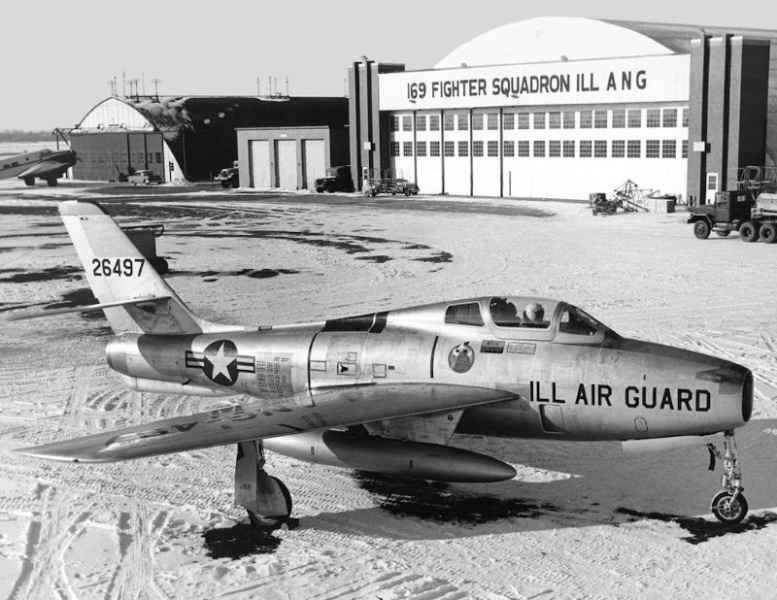
* While the Thunderstreak began life as a "minimum-change" derivative of the Thunderjet, in the end the two designs were substantially different aircraft. Along with the swept flight surfaces, more powerful engine, deeper fuselage, and bigger engine intake, the Thunderstreak differed from the Thunderjet by featuring:
The first 275 Thunderstreaks had the J65-W-1 engine, built by Curtiss-Wright; the next hundred had the improved J65-W-1A; and then production stabilized on the much more satisfactory J65-W-3 or Buick-built J65-B-3 engine. All had 32.1 kN (3,275 kgp / 7,220 lbf) thrust, the differences being changes to provide more reliability. Final production aircraft had the J65-W-7 or J65-B-7 with 34.7 kN (3,540 kgp / 7,800 lbf) thrust. Early production with the -1 or -1A engines could not be re-engined with later J65 variants; these aircraft had short service lives.
Armament was the same as for the F-84E, with six M3 Browning machine guns -- four in the nose, one in each wingroot -- and the F-84F featured four stores pylons, with a maximum load capacity of 2,720 kilograms (6,000 pounds). The Thunderstreak could not be fitted with wingtip tanks, but the inboard pylons were "wet" and could each carry a 1,705-liter (450 US gallon) external tank. As with the F-84G, the F-84F could carry a tactical nuclear weapon, with a LABS system for toss bombing. Incidentally, although Thunderstreaks often flew in natural metal colors, later in their lives disruptive camouflage paint schemes were often applied.
___________________________________________________________________
REPUBLIC F-84F THUNDERSTREAK:
___________________________________________________________________
wingspan:
10.24 meters (33 feet 7 inches)
wing area:
30.19 sq_meters (325 sq_feet)
length:
13.23 meters (43 feet 5 inches)
height:
4.39 meters (14 feet 5 inches)
empty weight:
6,275 kilograms (13,830 pounds)
MTO weight:
12,700 kilograms (28,000 pounds)
max speed, sea level:
1,120 KPH (695 MPH / 605 KT)
service ceiling:
14,000 meters (48,000 feet)
combat radius (with drop tanks):
1,305 kilometers (810 MI / 705 NMI)
___________________________________________________________________
The Air Force was not very happy with the F-84F at first. The engine, as mentioned, had reliability problems, while the aircraft landed unpleasantly "hot", and handled badly at high speeds. Production was suspended in 1954, with a Project RUN IN initiated to work out the problems. Production resumed in 1955.
Late production Thunderstreaks featured an "all-moving" tailplane, instead of the fixed tailplane with elevators of early production aircraft, which helped reduce the tendency of the aircraft to "pitch up" in high-speed stalls. However, there would always be limitations on maneuvers that might be attempted with the F-84F -- though in maturity, it was seen as a tough and reliable aircraft.
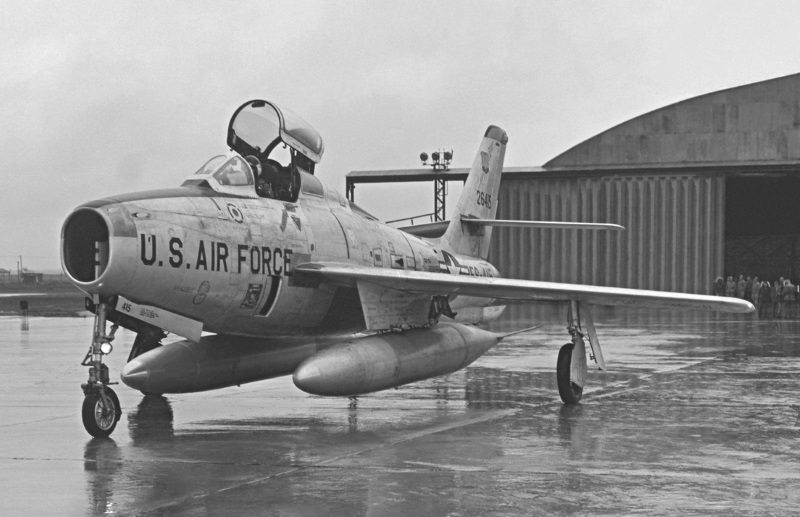
A total of 2,711 Thunderstreaks, not including the two protos, was built to end of production in August 1957. 2,112 of these were built by Republic at the company plant at Farmingdale, New York, while the remaining 599 were built by General Motors at a plant in Kansas City. There was some perception that GM-built Thunderstreaks were inferior to Republic-built ones. Of the total production, 1,410 went to the USAF.
The F-84F was introduced into USAF service in early 1954, initially being used as a long-range escort fighter by the Strategic Air Command (SAC), to protect the vulnerable Convair B-36 on long-range missions. Assignments of production were split evenly between SAC and TAC. There were 12 wings of Thunderstreaks by 1955, with six for SAC and six for TAC.
With the phase-out of the B-36 and its replacement by the Boeing B-52, the Thunderstreak became the mainstay of TAC, all F-84Fs being out of SAC service by 1957. They didn't remain in TAC service much longer, being replaced by the North American F-100 Super Sabre by the end of the decade. The Air Force Thunderbirds flew the Thunderstreak from 1955 into 1956, when it was also replaced by the F-100.
TAC Thunderstreaks were handed over to the ANG from early 1958. In 1961, Soviet agitation over Berlin led to the activation of four ANG wings flying the F-84F, with these aircraft then constituting three active USAF wings until 1964, when they were returned to the ANG again, being replaced by the McDonnell-Douglas F-4 Phantom. ANG use of the F-84F declined through the decade, with the last of them removed from service in 1971.
* 1,301 Thunderstreaks were provided under MAP to US allies, including Belgium, France, Germany, Greece, Italy, the Netherlands, and Turkey. French F-84Fs were the only Thunderstreaks to go to war, flying strikes against Egyptian targets from bases in Cyprus and Israel during the Anglo-French-Israeli invasion of Egypt in 1956. A Turkish F-84F was the only Thunderstreak known to have scored an air-to-air kill, shooting down an Iraqi Ilyushin Il-28 Beagle bomber that strayed into Turkish airspace on 16 August 1962.
* Two "YF-84J" Thunderstreaks were built as modifications of F-84F airframes obtained from the production line, one with a GE XJ73-GE-5 and the other with an XJ73-GE-7 engine, providing 38.9 kN (3,970 kgp / 8,750 lbf) and 39.7 kN (4,045 kgp / 8,920 lbf) thrust respectively. They were built as insurance due to the problems with the J65 engine. These machines had deeper fuselages and bigger intakes to accommodate the more powerful engines. They also had a distinctive "upper lip" like the F-86, presumably for a radar gunsight.
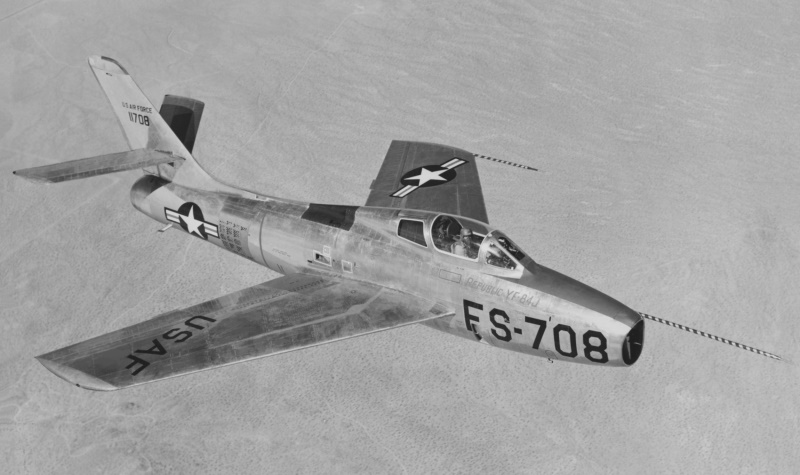
The first YF-84J prototype performed its initial flight on 7 May 1954. Performance was excellent, with the prototype breaking Mach 1 in level flight. However, the problems with the F-84F were resolved, and the second YF-84J prototype never flew. It is believed both machines reverted to F-85F standard, and went into operational service.
BACK_TO_TOP* As long as the USAF was obtaining the much improved F-84F Thunderstreak fighter, the Air Force decided to use the same machine as a reconnaissance aircraft to replace the Lockheed RF-80 Shooting Star. Since the reconnaissance mission implied a solid nose, the second YF-84F test machine, with the wing-root intakes, was used as a basis for the reconnaissance machine. The sole "YRF-84F" prototype of the "Thunderflash" performed its initial flight on 3 February 1952, with Carl Bellinger at the controls. Production was delayed by the same problems that afflicted the F-84F; although the first production "RF-84F" was delivered in 1953, the Thunderstreak wasn't in proper USAF service until 1955.
The intakes and wings were enlarged; each wing had twin fences, adopted to improve flight stability in response to YRF-84F tests. There were six cameras in the nose -- one forward-facing, one vertical, two to each side -- plus twin M3 Brownings on the outer walls of each air intake, for a total of four guns. The underwing stores pylons were retained for photoflash flares or external tanks; a spoiler was fitted to the top of each wing in later production to increase the roll rate, to make it easier to drop external tanks. Production machines featured a Wright J65-W-7 engine with 34.7 kN (3,535 kgp / 7,800 lbf) thrust.

A total of 715 RF-84Fs was built up to end of production in January 1958. The majority served with the USAF Tactical Air Command and Strategic Air Command. However, 386 of the total number were provided to US allies under MAP, with users including Belgium, Denmark, France, Greece, Italy, the Netherlands, Norway, Taiwan, Turkey, and West Germany.
The Thunderflash's service with the USAF was short-lived, the type being replaced by the McDonnell RF-101 Voodoo from the late 1950s, with the RF-84Fs passed on to the ANG. They remained in ANG service into the late 1960s. The RF-84F lingered on in foreign service through the next decade.
In the course of tensions between Turkey and Greece over Cyprus in the early 1960s, Thunderflashes of both sides reconnaissance sorties, with Turkish Thunderjets also participating in ground-attack missions in the theater in 1964. During further tensions in 1974, Turkish Thunderflashes flew more reconnaissance sorties, with one shot down. This appears to have been the only combat loss of an RF-84F.
BACK_TO_TOP* In the postwar period, the USAF investigated the "parasite fighter" concept, working on the "Fighter Conveyor (FICON)" project, in which a B-36 was to carry a Thunderjet nestled under the bomb bay -- the principle not being that the F-84 would provide an escort, but that it would perform a nuclear strike, the B-36 simply hauling the F-84 to within range of the target.
Tests were performed with a B-36 converted to carry an F-84E, trials beginning in 1952. They proved satisfactory enough to move on to the adaptation of a Thunderstreak to the FICON role, an F-84F being given a nose trapeze, plus a drooping tailplane to ease fit in the B-36, and assigned the designation of "YRF-84F".

Tests also showing that satisfactory, the Air Force committed to the concept -- though the role was changed to reconnaissance instead of nuclear strike, using the Thunderflash instead. Ten B-36 bombers were converted to carrier aircraft; 25 RF-84Fs were modified with a retractable skyhook and drooping tailplanes, to be redesignated "RF-84K". FICON actually went into formal service in the mid-1950s for about a year. Records suggest that it wasn't very practical, particularly with respect to recoveries in bad weather, and it never reached full operational status. In any case, the introduction of the long-range Lockheed U-2 "Angel" reconnaissance aircraft in 1956 -- and the phase-out of the B-36 -- meant the end of FICON.
* Another scheme, known as "Tip-Tow" or "MX-108A", involved a B-29 modified to allow F-84s to hook up wingtip-to-wingtip using a clamping module on each of the B-29's wingtips. Tip-Tow tests were conducted from 1950, which came to an abrupt end on 24 April 1953, when an F-84 flipped over and tore off the wing of the B-29, with all crew killed in the disaster. The problem was the presence of vortices around the B-29's wingtips that made the hookups very troublesome.
During 1955, the same concept was tested with a B-36 -- one earlier used for FICON tests -- and two RF-84Fs under the obscure program name of "Tom-Tom". Tom-Tom ran into the same problems as Tip-Tow, with an RF-84F actually torn away from the wingtip of the RB-36F on 23 September 1956. Nobody was hurt, but the scheme was immediately abandoned.
* FICON was not by any means the only unusual experiment in the Thunderjet line. In 1953, tests were performed using an F-84G "Zero Length Launch / Mat Landing (ZELMAL)" scheme. The idea was that the Thunderjet would be blasted into the air with an oversized JATO booster from a trailer-transporter -- and then land, gear up, on a huge inflatable mat, 25 x 245 x 1 meters (80 x 800 x 3 feet) in size, and snag an arresting cable to stop.
Tests were begun in December 1953 at Edwards AFB. The launches were performed off a trailer normally used to launch a Matador cruise missile, and it is plausible that the Matador JATO booster was used as well. Take-offs were surprisingly easy, but the mat landings were another matter. The inflatable mat, which was transported on a couple of trailer trucks, leaked the first time it was set up, and portions had to be sent back to Goodyear, the manufacturer, for repairs.

The first mat landing didn't take place until 2 June 1954. It was a fiasco. The F-84G's arresting hook tore up the mat, and the aircraft was so badly damaged that it had to be written off. The test pilot, Robert Turner, was laid up with back injuries for months. Two more mat landings were performed, and though the results were nowhere near as bad as the first landing, the idea was still clearly unworkable. George Rodney, one of the test pilots, described the mat landings: "We tied ourselves into the seat real well, so we wouldn't pitch forward into the control column and the instrument panel, but unfortunately your head, it goes into a big arc and comes down on your chest."
ZELMAL was terminated after 28 launches. Rodney commented: "It needed some work, that was for damn sure." The Air Force abandoned the concept for a time, though further work was performed later on zero-length launch of the North American F-100 Super Sabre and the Lockheed F-104 Starfighter, mat landing being wisely abandoned in favor of conventional landing on an airstrip. ZEL was never actually fielded, however; although it worked as specified in maturity, the scheme being seen as more trouble than it was worth.
* One of the most exotic of the offshoots of the Thunderjet was the "Thunderceptor", designed as the "AP-31" in response to a USAAF requirement issued in late 1945 for a high-speed, high-altitude interceptor capable of supersonic flight. Two "XP-91" prototypes were ordered in 1946, the first flying as the "XF-91" on 9 May 1949, with Carl Bellinger at the controls.
The XF-91 had some resemblance to the F-84, but it was largely a new aircraft. The Thunderceptor was a "hybrid" fighter, initially fitted with a single J47-GE-3 turbojet providing 23.1 kN (2,360 kgp / 5,200 lbf) thrust. This was then replaced with an afterburning variant that kicked up thrust by 30%. Finally, four Reaction Motors XLRII-RM-9 liquid fuel rocket motors -- also used on the Bell X-1 rocket plane -- providing 6.67 kN (680 kgp / 1,500 lbf) thrust each were added, with two fitted above the engine exhaust and two below.
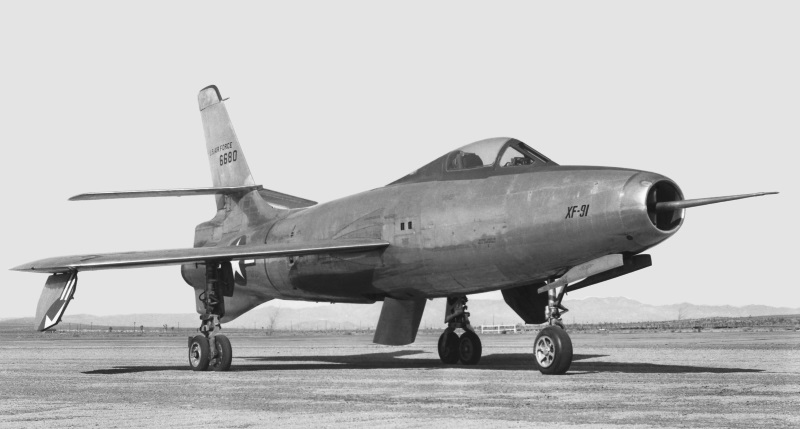
The wing design was very unusual. It had a sweep of 35 degrees and was wider and thicker at the wingtips than at the root, the idea being that this configuration provided good low-speed handling. The wing could be pivoted for a higher angle of attack on take-offs and landings, and had leading-edge slats to reduce landing speed. The main landing gear assemblies wouldn't fit into the inner wing, so they retracted outward into the wing. Each of the main gear assemblies had twin wheels arranged in tandem to allow them to fit into the wing. Armament was to be four 20-millimeter cannon, though armament was never actually fitted.
___________________________________________________________________
REPUBLIC XF-91 THUNDERCEPTOR:
___________________________________________________________________
wingspan:
9.52 meters (31 feet 3 inches)
wing area:
29.73 sq_meters (320 sq_feet)
length:
13.18 meters (43 feet 3 inches)
height:
5.51 meters (18 feet 1 inch)
empty weight:
7,190 kilograms (15,855 pounds)
MTO weight:
12,935 kilograms (28,515 pounds)
max speed at altitude:
1,585 KPH (985 MPH / 855 KT)
service ceiling:
15,250 meters (50,000 feet)
range with tanks:
1,885 kilometers (1,170 MI / 1,120 NMI)
___________________________________________________________________
Two XF-91s were built, the first flying on 9 May 1949. Once all the bugs were worked out, the Thunderceptor turned out to be blazingly fast, with a level speed of 1,810 KPH (1,125 MPH) in level flight with all five engines burning. Despite its somewhat eccentric design -- the thing looked like it had been dreamed up by a 1950s science-fiction writer -- the test pilots were very impressed with the machine and were disappointed that it did not go on to a production derivative, the program being abandoned to focus on development of what would become the Convair F-102 Delta Dagger, which led to the superlative F-106 Delta Dart.
In 1952, the first prototype Thunderceptor was refitted with a nose radome for AN/APS-6 radar at the top of the intake, while the second was refitted with a vee / butterfly-style tail. The vee tail had been envisioned at the outset, but had seemed too radical even for the XF-91; it reduced drag and provided incrementally higher speed. The first prototype, with the AN/APS-6 radar, is now on display at the USAF Museum in Dayton, Ohio.
* In another eccentric experiment, in the early 1950s, both the US Air Force and Navy were interested in turboprop-powered fighters, which had the potential for longer range and shorter take-offs with heavy loads than existing jet fighters. A team at Republic under Joseph Freeman came up with a design based on the Thunderstreak with the company designation of "AP-46". The program was given the go-ahead, and was given the military designation of "XF-106". The Navy dropped out, but the Air Force stayed with the effort. The name was changed to "XF-84H" and two prototypes were built, the first performing its initial flight on 22 July 1955.
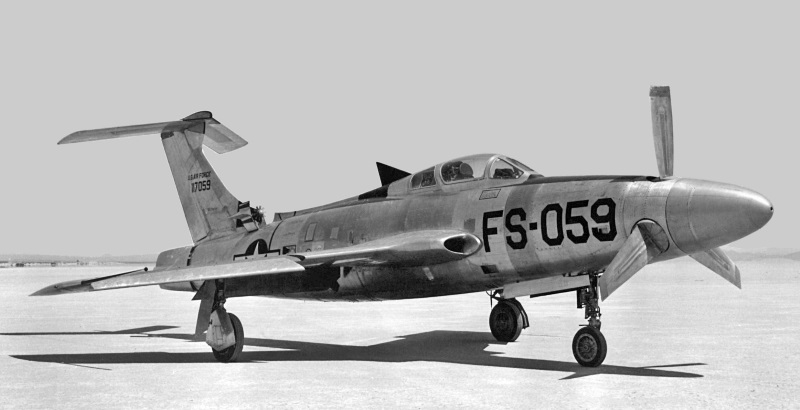
The XF-84H was powered by an Allison XT40-A-1 turboprop providing 4,360 ekW (5,850 EHP), the XT40 consisting of two T38 turboprop cores driving a single gearbox, and turning a three-bladed Aeroproducts propeller with a diameter of 3.66 meters (12 feet). It also featured a tee-tail arrangement, with an all-moving tailplane mounted on top of the tailfin -- the tee tail was to keep the tailplane out of the prop wash -- and a small triangular ventral fin behind the cockpit to help cancel torque.
___________________________________________________________________
REPUBLIC XF-84H:
___________________________________________________________________
wingspan:
10.21 meters (33 feet 6 inches)
wing area:
30.75 sq_meters (331 sq_feet)
length:
15.69 meters (51 feet 6 inches)
height:
4.69 meters (15 feet 5 inches)
empty weight:
7,890 kilograms (17,390 pounds)
normal weight:
10,435 kilograms (23,000 pounds)
max speed at altitude:
1,080 KPH (670 MPH / 580 KT)
range with tanks:
3,790 kilometers (2,355 MI / 2,050 NMI)
performance specifications are estimates
___________________________________________________________________
Potentially, the XF-84H was the fastest prop aircraft ever built, with an estimated speed of 1,080 KPH (670 MPH). It didn't get close to that, and in fact it was a nightmare in all respects. Early turboprops tended to be temperamental, and the XT40 appears to have been a particularly hard case. Flight tests suffered from continuous malfunctions, particularly of the gearbox; its handling was poor, particularly because of the vicious torque produced by the prop; and the noise levels produced were staggering, said to be able to make people nauseous blocks away. It had to be towed well away from human habitation before the engine was turned over; the machine was nicknamed the "Thunderscreech".
The second prototype was completed and did make it into the air in 1956, but by that time the Air Force had suffered enough of the project, and it was cancelled. The two prototypes had performed only twelve flights, and all but one had resulted in an emergency landing -- in some cases precautionary, the test pilots having learned fear of the thing. One XF-84H survives at the USAF Museum at Wright-Patterson AFB in Dayton, Ohio.
BACK_TO_TOP* Sources include:
* Illustration credits:
* Revision history:
v1.0.0 / 01 mar 17 v1.0.1 / 01 feb 19 / Review & polish. v1.1.0 / 01 mar 21 / Illustrations update. v1.1.1 / 01 may 21 / Minor fixes. v1.1.2 / 01 mar 23 / Review & polish.BACK_TO_TOP
